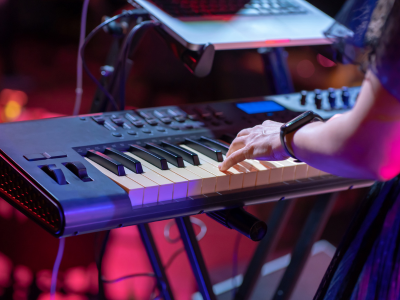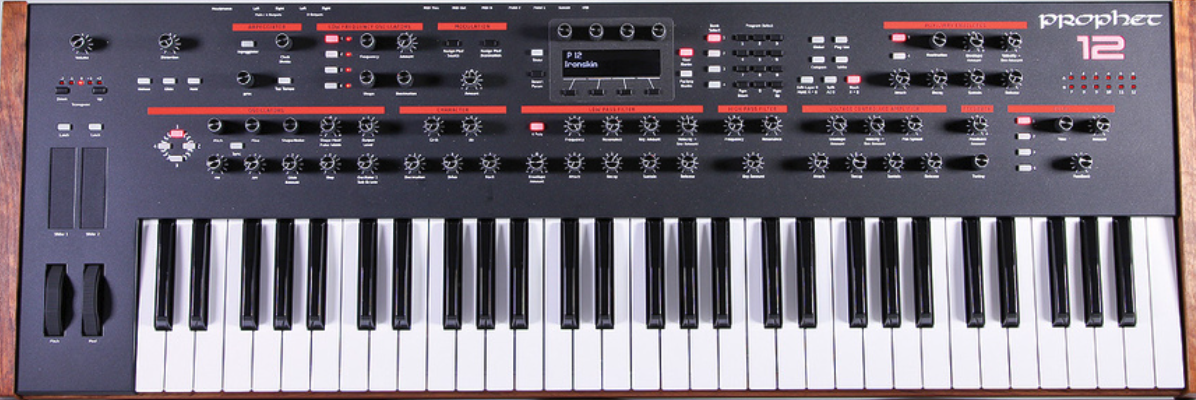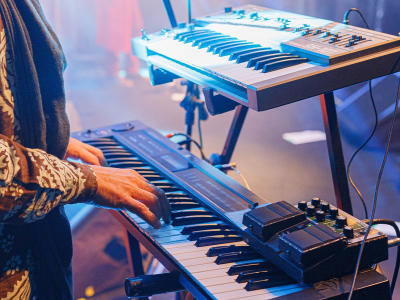What Keyboards Do Touring Musicians Actually Use On Stage?

When most fans watch a live show, they rarely think about what’s sitting behind the keyboard player. Yet for touring musicians, the keyboard rig can make or break a set. Every piece of gear needs to perform flawlessly night after night while still giving the player flexibility and expression.
As someone who has toured for over ten years with Vinyl Theatre, I’ve learned firsthand how personal and practical these setups become. From tiny clubs to major festivals, the gear that survives life on the road usually earns its spot the hard way.
The Truth About Touring Keyboard Rigs
There’s no universal touring setup. Some musicians travel with massive analog rigs, while others rely on one versatile workstation. What matters most is reliability, consistency, and the ability to recall sounds instantly.
Every band also faces its own production realities: van tours versus fly dates, stage size, and whether you’re syncing to a click track or playing completely live. My approach evolved through years of problem-solving and learning what could take a beating on the road.
My Touring Background With Vinyl Theatre
During my time with Vinyl Theatre, I performed more than 400 shows across the U.S. We opened for bands like Twenty One Pilots, and our shows relied heavily on synths and layered textures.
To pull this off live, my rig became a hybrid setup—part MIDI control center, part analog synth collection. It had to replicate the record while still letting me perform dynamically and adapt on stage.
The Ideal Modern Keyboard Rig Setup
If I were designing an ideal touring setup today, it would combine both the flexibility of a MIDI controller and the warmth of true hardware synths. The combination gives you precise control over your sounds while maintaining the tactile feel every player wants.
Here’s a look at what I’d build out—and what I used for nearly a decade.
Using an 88-Key MIDI Controller on Tour
A solid 88-key MIDI controller is the foundation of most live keyboard rigs. For me, that’s currently the Arturia KeyLab 88 MK3. It’s fully weighted, feels authentic under the fingers, and integrates seamlessly with Ableton Live.
I like using Ableton because it keeps everything synchronized—click tracks, patch changes, and even lighting triggers can run from the same session. The KeyLab MK3 lets you map everything to pads and sliders for instant control.
Back in the Vinyl Theatre days, I used the Roland FA-08 as my main controller. It has 16 pads, great key action, and worked perfectly as both a MIDI brain and a standalone synth when needed.
Hardware Synths That Bring Live Energy
While MIDI control gives flexibility, you can’t beat the presence of real synths on stage. For me, Dave Smith Instruments have always delivered that unmistakable tone. I relied heavily on the Prophet 12, a powerhouse hybrid synth that became the core of our live sound.
If you want a smaller analog counterpart, something like the Sequential Pro 3 or Moog Subsequent 37 adds grit and character. I love having a mono synth dedicated to bass or leads—it brings movement and rawness that sample-based patches rarely capture.
A Typical Live Rig Breakdown
|
Component |
Model Example |
Purpose |
|
MIDI Controller |
Arturia KeyLab 88 MK3 / Roland FA-08 |
Controls Ableton and triggers virtual instruments |
|
Hardware Poly Synth |
Dave Smith Prophet 12 |
Pads, arps, and lush evolving sounds |
|
Hardware Mono Synth |
Moog Subsequent 37 / Sequential Pro 3 |
Bass lines and expressive leads |
|
Laptop & Interface |
MacBook Pro + Universal Audio Apollo |
Runs Ableton Live, click tracks, and handles pro-level audio routing |
|
Pedals / Extras |
Volume, sustain, and expression pedals |
Real-time performance control |
This blend gives you everything you need for a professional live setup—powerful control, authentic tone, and redundancy in case one element goes down.

Recommended Keyboards for Touring Musicians
If you’re putting together your first live setup or looking to upgrade, here are a few standout keyboards that consistently perform well on stage:
|
Model |
Why It’s Great for Touring |
|
Roland Fantom 08 |
Combines workstation power with road-ready build and deep integration for live patch switching. |
|
Nord Stage 4 |
A staple among professional players; unmatched for pianos, organs, and synth layering in a durable chassis. |
|
Korg Nautilus |
Excellent key action, intuitive touchscreen, and dependable sound engines for all genres. |
|
Yamaha CP88 |
Pure performance piano with natural feel and rock-solid reliability for touring pianists. |
|
Arturia KeyLab 88 MK3 |
Ideal for hybrid setups that integrate hardware and software; perfect if you rely on Ableton or MainStage. |
Each of these boards has earned its place on major stages for a reason. They’re designed for life on the road, with great key action, dependable build quality, and flexible connectivity. Choosing one comes down to your play style, weight preferences, and whether you lean more toward hardware or software-based performances.

Final Thoughts: Every Rig Is Different
Every touring musician develops their own philosophy on gear. Some prioritize simplicity, others chase perfect sound design. My advice is to build a rig that inspires you to perform confidently every night, while staying practical enough to survive airport baggage handlers.
The beauty of modern keyboards is that you can mix hardware and software seamlessly. This article reflects my own path, not a one-size-fits-all answer. If you’re experimenting with your live setup, I break down the best keyboards for every budget and purpose at Digitalpianokraze.
*******************************************
